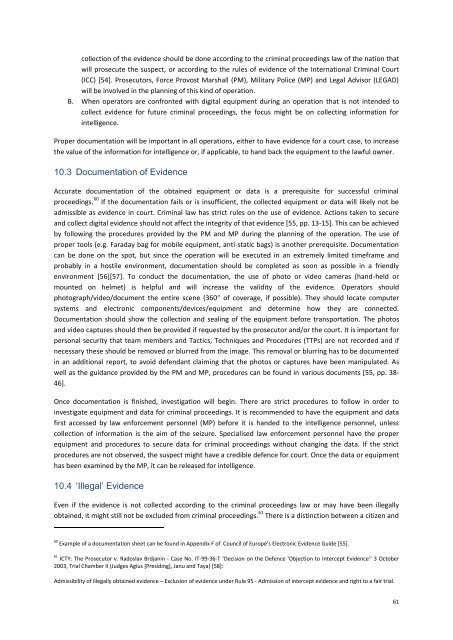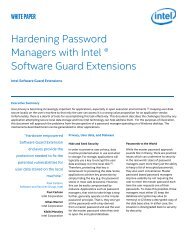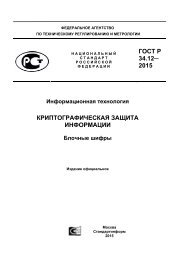BATTLEFIELD DIGITAL FORENSICS
BDF_Battlefield_Digital_Forensics_final
BDF_Battlefield_Digital_Forensics_final
Create successful ePaper yourself
Turn your PDF publications into a flip-book with our unique Google optimized e-Paper software.
collection of the evidence should be done according to the criminal proceedings law of the nation that<br />
will prosecute the suspect, or according to the rules of evidence of the International Criminal Court<br />
(ICC) [54]. Prosecutors, Force Provost Marshall (PM), Military Police (MP) and Legal Advisor (LEGAD)<br />
will be involved in the planning of this kind of operation.<br />
B. When operators are confronted with digital equipment during an operation that is not intended to<br />
collect evidence for future criminal proceedings, the focus might be on collecting information for<br />
intelligence.<br />
Proper documentation will be important in all operations, either to have evidence for a court case, to increase<br />
the value of the information for intelligence or, if applicable, to hand back the equipment to the lawful owner.<br />
10.3 Documentation of Evidence<br />
Accurate documentation of the obtained equipment or data is a prerequisite for successful criminal<br />
proceedings. 60 If the documentation fails or is insufficient, the collected equipment or data will likely not be<br />
admissible as evidence in court. Criminal law has strict rules on the use of evidence. Actions taken to secure<br />
and collect digital evidence should not affect the integrity of that evidence [55, pp. 13-15]. This can be achieved<br />
by following the procedures provided by the PM and MP during the planning of the operation. The use of<br />
proper tools (e.g. Faraday bag for mobile equipment, anti-static bags) is another prerequisite. Documentation<br />
can be done on the spot, but since the operation will be executed in an extremely limited timeframe and<br />
probably in a hostile environment, documentation should be completed as soon as possible in a friendly<br />
environment [56][57]. To conduct the documentation, the use of photo or video cameras (hand-held or<br />
mounted on helmet) is helpful and will increase the validity of the evidence. Operators should<br />
photograph/video/document the entire scene (360° of coverage, if possible). They should locate computer<br />
systems and electronic components/devices/equipment and determine how they are connected.<br />
Documentation should show the collection and sealing of the equipment before transportation. The photos<br />
and video captures should then be provided if requested by the prosecutor and/or the court. It is important for<br />
personal security that team members and Tactics, Techniques and Procedures (TTPs) are not recorded and if<br />
necessary these should be removed or blurred from the image. This removal or blurring has to be documented<br />
in an additional report, to avoid defendant claiming that the photos or captures have been manipulated. As<br />
well as the guidance provided by the PM and MP, procedures can be found in various documents [55, pp. 38-<br />
46].<br />
Once documentation is finished, investigation will begin. There are strict procedures to follow in order to<br />
investigate equipment and data for criminal proceedings. It is recommended to have the equipment and data<br />
first accessed by law enforcement personnel (MP) before it is handed to the intelligence personnel, unless<br />
collection of information is the aim of the seizure. Specialised law enforcement personnel have the proper<br />
equipment and procedures to secure data for criminal proceedings without changing the data. If the strict<br />
procedures are not observed, the suspect might have a credible defence for court. Once the data or equipment<br />
has been examined by the MP, it can be released for intelligence.<br />
10.4 ‘Illegal’ Evidence<br />
Even if the evidence is not collected according to the criminal proceedings law or may have been illegally<br />
obtained, it might still not be excluded from criminal proceedings. 61 There is a distinction between a citizen and<br />
60 Example of a documentation sheet can be found in Appendix F of Council of Europe’s Electronic Evidence Guide [55].<br />
61 ICTY: The Prosecutor v. Radoslav Brdjanin - Case No. IT-99-36-T ‘Decision on the Defence 'Objection to Intercept Evidence'‘ 3 October<br />
2003, Trial Chamber II (Judges Agius [Presiding], Janu and Taya) [58]:<br />
Admissibility of illegally obtained evidence – Exclusion of evidence under Rule 95 - Admission of intercept evidence and right to a fair trial.<br />
61





